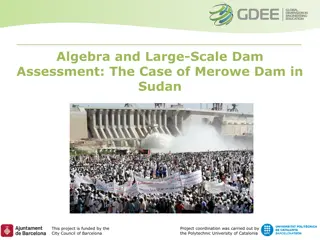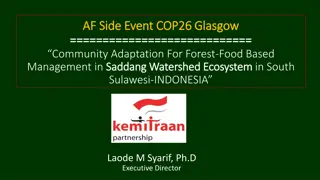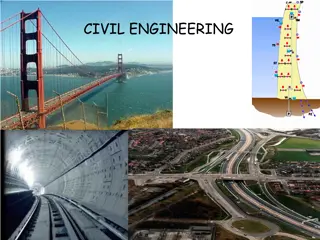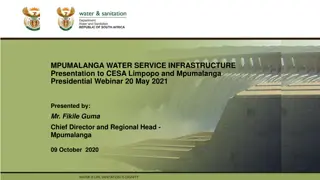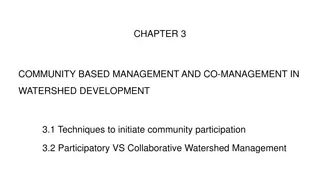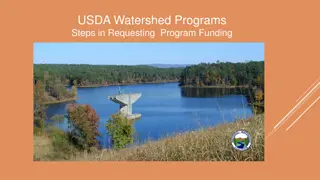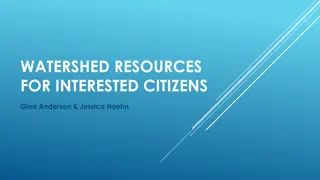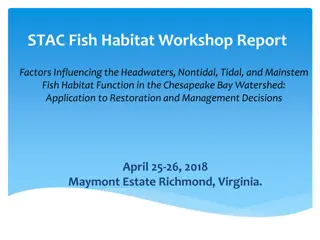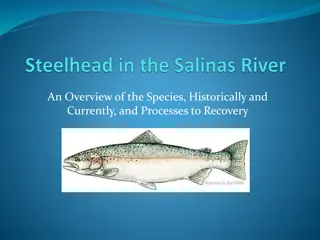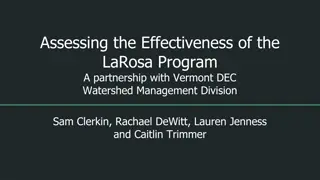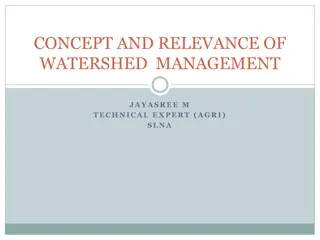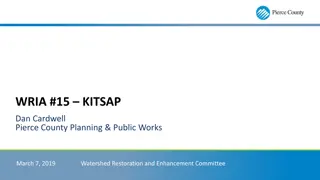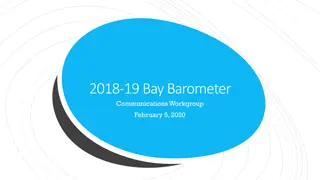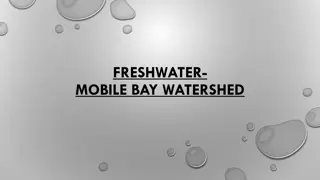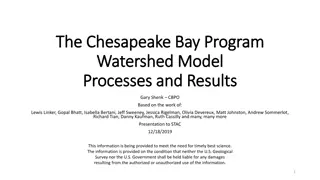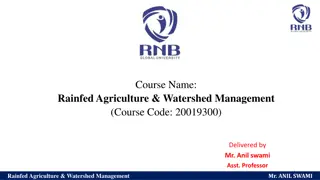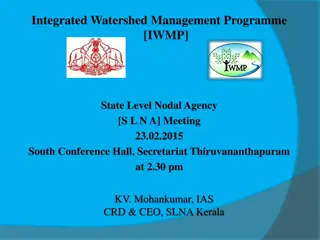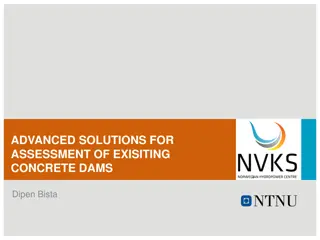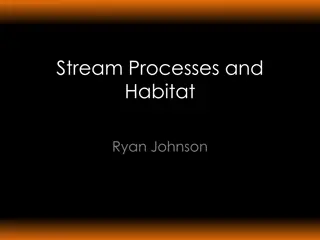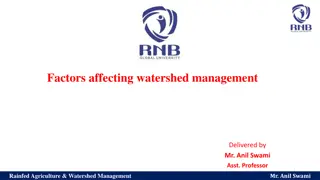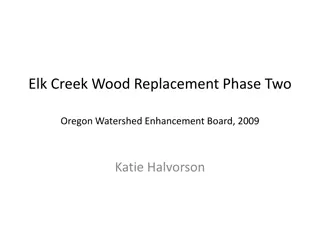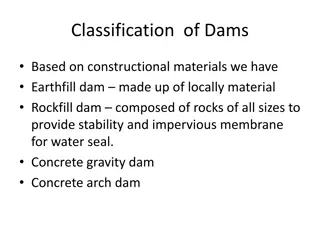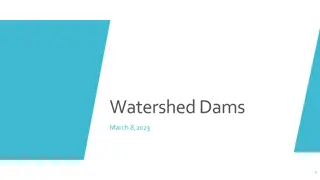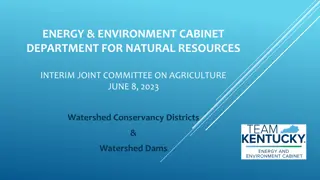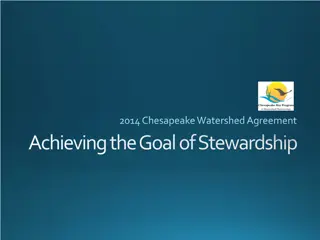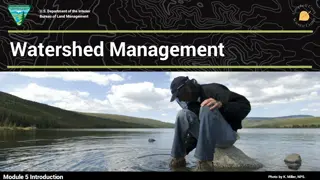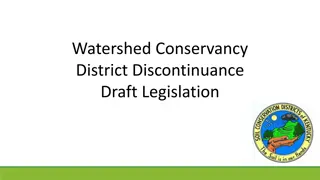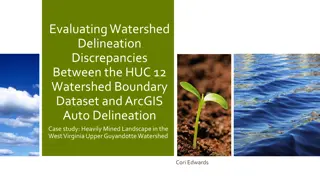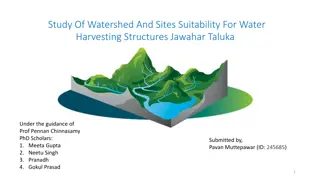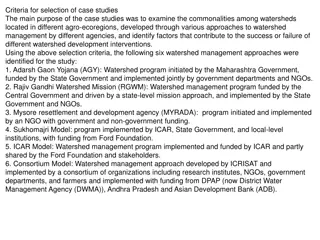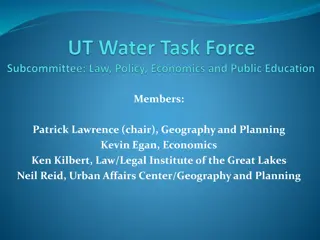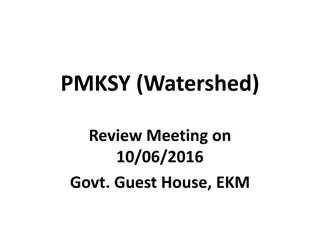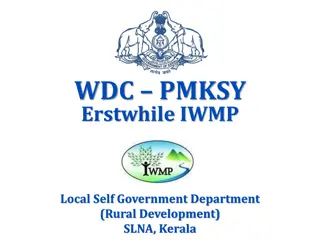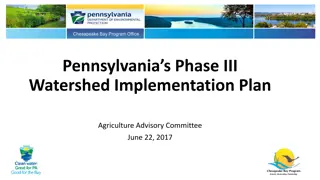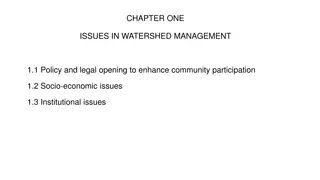Stakeholder Engagement in Northern Colorado Water
Explore stakeholder engagement, collaboration, and water management in Northern Colorado, focusing on the Cache la Poudre watershed. Discover the various uses of the watershed, key groups involved in its preservation, and ongoing projects like the Northern Integrated Supply Project. Join the convers
0 views • 14 slides
Engineering Education and Large-Scale Dam Assessment: The Case of Merowe Dam in Sudan
This project, coordinated by the Polytechnic University of Catalonia and funded by the City Council of Barcelona, focuses on the global dimensions of engineering education, specifically in the context of algebra and large-scale dam assessment using the Merowe Dam in Sudan as a case study. The conten
1 views • 20 slides
Enhancing Community Resilience in South Sulawesi: A Sustainable Approach to Climate Adaptation
Empowering communities in the Saddang Watershed Ecosystem, South Sulawesi, Indonesia, to enhance their resilience against climate change. Projects focus on forest-food management, urban climate solutions, coastal community adaptation, and indigenous watershed governance. The initiative aims to stren
4 views • 8 slides
Civil Engineering: Dams, Reservoirs, and Geological Considerations
Civil engineering work encompasses various structures like dams, embankments, motorways, bridges, buildings, and more. Building dams and reservoirs involves considerations of geological factors, rock properties, and structural design. Different types of dams, such as gravity dams and arch dams, serv
0 views • 23 slides
Overview of Mpumalanga Water Service Infrastructure
Mpumalanga province in South Africa encompasses an area of 79,490 km2 and shares its boundaries with Mozambique, eSwatini, Lesotho, Namibia, and Botswana. The province has 26 main dams and water transfer schemes connecting it to other regions. There are three district municipalities and 17 local mun
0 views • 10 slides
Community-Based Management in Watershed Development
Techniques to initiate community participation in watershed management are crucial for sustainable development. Scholars classify participation levels into different categories, highlighting the importance of ideological motivation and voluntary engagement. The shift from direct intervention to part
0 views • 28 slides
Environmental Challenges in Assam: Solid Waste Management, Deforestation & Watershed Management
Assam faces environmental problems related to solid waste management, deforestation, and watershed management. Solid waste, including municipal, industrial, and biomedical waste, poses a significant threat to human health if not handled properly. Deforestation, the permanent removal of trees for var
1 views • 15 slides
USDA Watershed Programs for Local Communities
USDA Watershed Programs offer assistance in addressing natural resource issues such as flood control, repairing flood damages, and rehabilitating flood control dams. The three major components - Emergency Watershed Program (EWP), Watershed Protection and Flood Control Program (WPFO), and Watershed R
1 views • 15 slides
Watershed Resources for Interested Citizens
Explore a variety of resources related to watersheds, wetlands, and water monitoring, including tools provided by the U.S. Fish and Wildlife Services National Wetland Inventory. Learn about different types of wetlands, access the Indiana Watershed Group Finder for locating hydrologic unit codes, and
3 views • 18 slides
Factors Influencing Fish Habitat in Chesapeake Bay Watershed Workshop Report
This workshop report delves into the factors affecting fish habitat function in the Chesapeake Bay Watershed, focusing on headwaters, nontidal, tidal, and mainstem areas. It outlines the workshop process, assessment frameworks, and user needs to support restoration and management decisions. The repo
1 views • 31 slides
Challenges and Efforts for Steelhead Recovery in Salinas River Watershed
Steelhead in the Salinas River watershed have faced a historic lack of documentation and a rapid decline since the 1960s. The current status indicates a threat to their existence, with various factors contributing to their decline. Issues such as water quality, barriers to passage, and human activit
1 views • 11 slides
Evaluating Effectiveness of LaRosa Program in Partnership with Vermont DEC Watershed Management Division
This project aims to assess the LaRosa program's effectiveness through fostering communication, evaluating its impact, and identifying challenges faced by watershed associations. Various methods such as interviews, surveys, and email communication were used to gather insights. Key questions revolved
0 views • 18 slides
Urgency of Watershed Management for Sustainable Agriculture
Watershed management is crucial due to dwindling land availability, water scarcity projections, and the severe threat of soil erosion and land degradation. With vast regions affected by these issues, especially in rainfed areas, there is a pressing need to address resource degradation to ensure food
0 views • 50 slides
Unlocking Dry Land Agriculture Potential: Doubling Farmer Income through Watershed Approach
Dr. C.S. Kedar emphasizes the importance of promoting appropriate institutional mechanisms to double the income of dryland farmers through watershed-centric approaches. The proposed method focuses on aggregating goods and services, leveraging markets, and accessing government schemes. Key elements i
0 views • 34 slides
Optimizing Riparian Buffers for Thermal Protection in Teanaway River Watershed
Explore the study comparing optimized riparian buffer designs with fixed-width buffers in non-fish bearing streams of the Teanaway River watershed, focusing on maximizing thermal energy reductions with considerations for channel orientation and forest density. By utilizing NetMaps and thermal energy
0 views • 24 slides
Watershed Restoration and Development Policies in Pierce County
This content provides detailed information about Watershed Restoration and Enhancement Committee activities, growth management planning, buildable lands, housing unit trends, population data, development regulations, land characteristics, and water policy in Pierce County, specifically focusing on W
0 views • 11 slides
2018-19 Bay Barometer Communications Workgroup Report
Annual report on watershed health and restoration, highlighting the lack of updated indicators and providing insights into the improved indicators concerning blue crab abundance, protected lands, public access, RPI, and SAV metrics. The report outlines the progress made in various areas within the C
0 views • 12 slides
Freshwater Mobile Bay Watershed
The Mobile Bay Watershed covers a vast area across multiple states, with various rivers and water bodies interconnected through a network of tributaries. Major Alabama rivers, including the Mobile River and the Tombigbee River, flow through this watershed, supporting diverse ecosystems. However, env
0 views • 8 slides
Chesapeake Bay Program Watershed Model Overview
The Chesapeake Bay Program's Watershed Model, presented to STAC in December 2019, provides insights on long-term average pollutant loads and land use dynamics in the Chesapeake Bay watershed. The model incorporates inputs such as land use acres, BMPs, and delivery mechanisms to estimate pollutant lo
0 views • 41 slides
Rainfed Agriculture & Watershed Management Course Overview
This course on Rainfed Agriculture & Watershed Management, delivered by Mr. Anil Swami, covers topics such as soil and climatic conditions in rainfed areas, water harvesting techniques, contingent crop planning, seasonal rainfall analysis, and soil conservation practices. It emphasizes the significa
1 views • 22 slides
Integrated Watershed Management Programme State Level Nodal Agency Meeting Report
The State Level Nodal Agency meeting for the Integrated Watershed Management Programme was held on 23rd February 2015 in Thiruvananthapuram, where various agenda items were discussed, including confirmation of previous meeting minutes, action taken reports, project approvals, and resolving project d
0 views • 54 slides
Advanced Solutions for Concrete Dam Assessment
Utilizing advanced methods for the assessment of existing concrete dams is crucial for ensuring their stability and safety. This project focuses on analyzing the stability of small concrete dams in Norway built between 1950-1970, which may not meet current safety standards. The study involves evalua
0 views • 12 slides
Watershed Processes and Habitat Impact
Explore the intricate relationship between stream processes, watershed factors, and habitat effects on local wildlife. Learn how climate, geology, soil, vegetation, water, and land use play crucial roles in shaping ecosystems. Discover the importance of maintaining a healthy vegetative community for
0 views • 27 slides
Factors Influencing Watershed Management Explained by Mr. Anil Swami
Mr. Anil Swami, an Assistant Professor specializing in Rainfed Agriculture & Watershed Management, discusses the factors affecting watershed management. These factors are categorized into watershed characteristics, climatic characteristics, land use patterns, social status, and organization. Watersh
0 views • 18 slides
Elk Creek Wood Replacement Project Overview
This project, led by the Oregon Watershed Enhancement Board in 2009 and documented by Katie Halvorson, focuses on the replacement of wood structures in Elk Creek to enhance watershed function and habitat complexity for juvenile coho salmon. By addressing the lack of large wood, the initiative aims t
0 views • 20 slides
Classification and Principles of Earth and Rockfill Dams
Classification of dams based on construction materials includes earthfill and rockfill dams made of locally sourced materials, concrete gravity and arch dams. Further classifications include homogeneous and zoned earth and rockfill dams. Principles of analysis and design for such dams involve site i
0 views • 4 slides
Watershed Dams Rehabilitation Program in Kentucky
The Watershed Dams Rehabilitation Program in Kentucky aims to address the critical need for rehabilitating high hazard dams to ensure public safety and prevent economic damage. With funds allocated for grant programs and local sponsor matches, the initiative targets key priority dams identified by t
0 views • 8 slides
Watershed Conservation and Dam Rehabilitation Initiatives Overview
Explore the functions and responsibilities of Watershed Conservancy Districts in maintaining watershed dams, the funding mechanisms for dam rehabilitation projects, and the prioritized dam rehabilitation initiatives in Kentucky. Learn about the Watershed Dam Fund and its role in supporting the rehab
1 views • 8 slides
Achieving the Goal of Stewardship in the Chesapeake Watershed Agreement
The Chesapeake Watershed Agreement aims to increase the number and diversity of local citizen stewards and local governments supporting conservation and restoration activities for healthy local streams, rivers, and the Chesapeake Bay. Recognizing the importance of local involvement, citizen stewards
0 views • 8 slides
Watershed Management: Balancing Needs and Resources
Exploring the importance of watersheds in providing natural resources, the consequences of human modifications, and how communities strive to balance human needs with protecting watershed health. This module delves into the sources of community essentials like water, electricity, and heat, emphasizi
1 views • 12 slides
New Procedure for Watershed Conservancy District Discontinuance
A draft legislation proposes a new procedure for discontinuing inactive Watershed Conservancy District boards. Key points include criteria for initiating discontinuance, public notification requirements, voting procedures, and provisions for district boundaries and responsibilities. The legislation
0 views • 6 slides
Evaluating Watershed Delineation Discrepancies in West Virginia
This case study explores differences between NRCS Watershed Boundary Dataset and ArcGIS auto delineation in the Upper Guyandotte Watershed in West Virginia. The project aims to quantify discrepancies, analyze landscape characteristics, examine mining impacts, and assess the variations' effects on hy
0 views • 18 slides
Sustainable Watershed Planning in Stevens County, Washington
The Colville River watershed, known as WRIA 59, is the focus of sustainable watershed planning in Stevens County, Washington. The planning aims to address current and future water needs while protecting and enhancing the water resources within the area. Regulations around water rights, land use, and
2 views • 19 slides
Study of Watershed and Sites Suitability for Water Harvesting in Jawhar Taluka
This project aims to address water scarcity in Jawhar Taluka by studying watershed characteristics and identifying suitable sites for water harvesting structures. The methodology includes DEM analysis using QGIS Grass, watershed delineation, stream extraction, and site suitability assessment based o
0 views • 4 slides
Analysis of Different Watershed Management Approaches in Various Agro-Ecoregions
This study examines six different watershed management approaches implemented in diverse agro-ecoregions, focusing on the commonalities, success, and failures of interventions. The case study of Adarsh Gaon Yojana (AGY) in Maharashtra highlights the principles and approach towards sustainable villag
0 views • 13 slides
Watershed Management Research Projects in Maumee Watershed
Explore five key research tasks focusing on policies, practices, and impacts concerning nutrient loading into Lake Erie from the Maumee Watershed. Projects include examining CAFOs and CAFFs, declaring the Maumee a distressed watershed, regulating nutrients on farmland, addressing residential lawn fe
0 views • 6 slides
Progress Review Meeting for PMKSY Watershed Projects - Financial Updates and Project Status Assessment
The review meeting held on 10/06/2016 at the Government Guest House in EKM discussed the financial progress and project status of PMKSY Watershed Projects in various districts including Kasargode, Kannur, Kozhikode, Malappuram, Palakkadu, and Wayanadu. The detailed analysis included the project cost
1 views • 64 slides
Watershed Development Programme in Kerala: A Comprehensive Overview
The Watershed Development Programme in Kerala underwent significant transformations over the years, evolving from the Integrated Watershed Management Programme to its current form under the Pradhan Mantri Krishi Sinchayee Yojana. The program's implementation involves various institutional mechanisms
0 views • 43 slides
Pennsylvania's Phase III Watershed Implementation Plan
Pennsylvania's Phase III Watershed Implementation Plan focuses on reducing nitrogen, phosphorus, and sediment loading to meet Chesapeake Bay Total Maximum Daily Load requirements by 2025. The plan involves various sectors like agriculture, urban runoff, and forest areas to achieve necessary reductio
0 views • 30 slides
Issues in Watershed Management: Policy, Legal, and Community Participation
Policy and legal frameworks play a crucial role in enhancing community participation in watershed management. Understanding policy impacts, participatory processes, and implementation strategies are key for effective management planning. Definitions of policy, its components, and what it is not are
0 views • 81 slides

